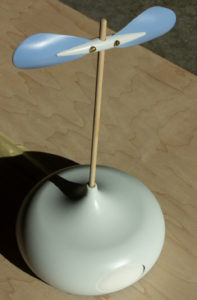Benal Johnson
MDes Fall 2022
Rethinking design paradigms around technology.
Introduction
The variety of design decisions around interfaces, contextuality, and emotion in current smart home technology leaves a case for exploring how they could be designed differently. This thesis examines a new paradigm of interacting with technology in which devices are designed contextually, expressively, and with tangible and embodied methods of control. These themes are explored in a case study in which three smart home devices are redesigned to express their personalities through form language, physical actuation, and embodied methods of control. Each device lives in a distinct context in the home – the bedroom, living room, and bathroom – and has a practical function that matches with each context.
To execute this case study, a four phase approach was used. First, contextual inquiries were conducted with participants to uncover the routines in their daily lives to determine appropriate contexts in which to design an expressive IoT intervention. Second, low fidelity prototypes and interaction models were made in response to the needs uncovered in the preliminary interviews, ensuring they fit into appropriate contexts in the home. Third, a framework was created to match IoT devices with distinct personalities and practical actions within their given context in a person’s routine. Finally, high-fidelity prototypes were fabricated using a variety of tools and filmed in a narrative format that brings both their interaction and sentimentality to life.
Motivation
At present, we primarily interact with technology in our day to day behind GUIs and NUIs through our smartphones, computers, and home smart devices. Smart devices especially are these monolithic hubs designed to be clean and ultramodern, utilizing only the most cutting edge technologies to enable their interactions. Yet, why do they have to be designed in this way with these specific interaction modalities?
The design of modern smart home devices do not take into account that people behave differently in each context and that their rhythms and needs change in every space. They also certainly don’t take into account the value of human emotions in everyday interactions; we are emotional, social creatures who feel and experience things and I find it strange that most technology seems to ignore that.
Final Design
The final outcome of this work is a set of three smart home devices that each have a highly expressive personality through actuation and form design. Each device lives in a specific context in the home that correlates to one of the “rhythmic moments” discovered in contextual inquiry. In addition, each device has one practical output that maps to its context; for example, the device that gets you ready for the day tells you the weather.
The first device, Snor, lives in the bedroom area of the home and helps you get ready for your day by telling you the weather.

The second device, Tobi, holds the user’s keys, turning the lights off when the user takes the keys when leaving the house and turning them on again once the keys are returned.

The third and final device, Mu, is a motherly figure that helps you to wind down for bed.

Conclusion
This work has the potential to demonstrate novel ways in which we might design technology, emphasizing usability and enjoyment of interaction over forcing users to adopt new and underdeveloped innovations. It contributes to several fields in the HCI and Human-Robot Interaction space, drawing upon themes such as ubiquitous computing, calm computing, slow technology, and emotional durability to inform its design and execution. I hope that this work leaves a lasting impact on how technology of the future might be designed to facilitate improved interactions between people and technology
Full listing

